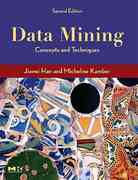Given a user-community bipartite graph, where the nodes are users and communities, and links indicate the membership
Question:
Given a user-community bipartite graph, where the nodes are users and communities, and links indicate the membership between users and communities. We can represent this bipartite graph by its adjacency matrix \(\mathbf{A}\), where \(\mathbf{A}(i, j)=1\) means user \(i\) belongs to community \(j\); and \(\mathbf{A}(i, j)=0\) otherwise. We further approximate the adjacency matrix \(\mathbf{A}\) by the multiplication of two low-rank matrices, that is, \(\mathbf{A} \approx \mathbf{F G}\), where \(\mathbf{F}\) and \(\mathbf{G}\) are two low-rank matrices. Describe how you can leverage the above low-rank approximation result to detect
(a) outlying users and
(b) outlying user-community memberships, respectively.
Step by Step Answer:

Data Mining Concepts And Techniques
ISBN: 9780128117613
4th Edition
Authors: Jiawei Han, Jian Pei, Hanghang Tong





